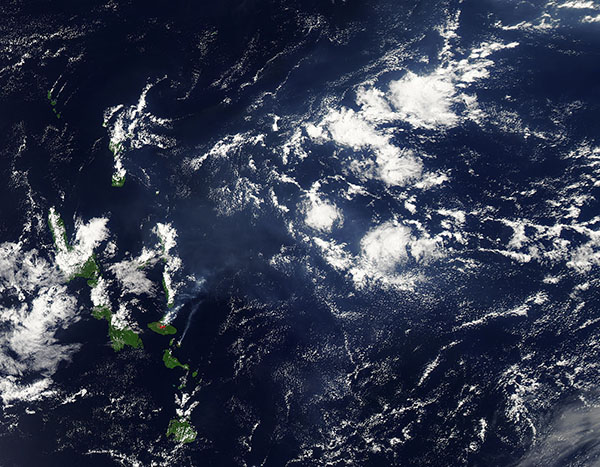Images
February 19, 2018 - Vog from Ambrym and Lopevi volcanoes, Vanuatu
Tweet
NASA’s Aqua satellite passed above Vanuatu on February 13, 2018, allowing the Moderate Resolution Imaging Spectroradiometer (MODIS) on board to acquire a true-color image of vog from a pair of active volcanoes filling the skies over the South Pacific Ocean.
The beautiful islands of Vanuatu are home to a number of active volcano, including Ambrym and Lopevi, which frequently emit ash and gases into the atmosphere, and sometimes also have more spectacular eruptions with lava ejection and lava lake formation, especially on Ambrym.
Ash plumes rise into the atmosphere from the vents of the volcanoes, typically appearing gray in true-color images. When gasses are emitted, however, they are invisible unless they form “vog”, or volcanic smog, which is the hazy air pollution caused by volcanic gas and steam eruption. The emissions are typically primarily water vapor (steam) and may also contain carbon dioxide and sulfur dioxide. Sulfur dioxide can react in the atmosphere with moisture, sunlight, oxygen and other gases and particulate matter. Thee reaction creates very fine particles in the atmosphere and these scatter sunlight, causing visible haze. The haze may contain both particulate matter (PM 2.5) and sulfur dioxide, each of which can cause health problems. Sulfur dioxide is an irritating gas while PM 2.5 are very fine particles – smaller than the diameter of a human hair – which can enter the lung and cause irritation.
Image Facts
Satellite:
Aqua
Date Acquired: 2/13/2018
Resolutions:
1km (229.8 KB), 500m (757.3 KB), 250m (1.8 MB)
Bands Used: 1,4,3
Image Credit:
Jeff Schmaltz, MODIS Land Rapid Response Team, NASA GSFC
Tweet
NASA’s Aqua satellite passed above Vanuatu on February 13, 2018, allowing the Moderate Resolution Imaging Spectroradiometer (MODIS) on board to acquire a true-color image of vog from a pair of active volcanoes filling the skies over the South Pacific Ocean.
The beautiful islands of Vanuatu are home to a number of active volcano, including Ambrym and Lopevi, which frequently emit ash and gases into the atmosphere, and sometimes also have more spectacular eruptions with lava ejection and lava lake formation, especially on Ambrym. Ash plumes rise into the atmosphere from the vents of the volcanoes, typically appearing gray in true-color images. When gasses are emitted, however, they are invisible unless they form “vog”, or volcanic smog, which is the hazy air pollution caused by volcanic gas and steam eruption. The emissions are typically primarily water vapor (steam) and may also contain carbon dioxide and sulfur dioxide. Sulfur dioxide can react in the atmosphere with moisture, sunlight, oxygen and other gases and particulate matter. Thee reaction creates very fine particles in the atmosphere and these scatter sunlight, causing visible haze. The haze may contain both particulate matter (PM 2.5) and sulfur dioxide, each of which can cause health problems. Sulfur dioxide is an irritating gas while PM 2.5 are very fine particles – smaller than the diameter of a human hair – which can enter the lung and cause irritation.
Image Facts
Satellite:
Aqua
Date Acquired: 2/13/2018
Resolutions:
1km (229.8 KB), 500m (757.3 KB), 250m (1.8 MB)
Bands Used: 1,4,3
Image Credit:
Jeff Schmaltz, MODIS Land Rapid Response Team, NASA GSFC




